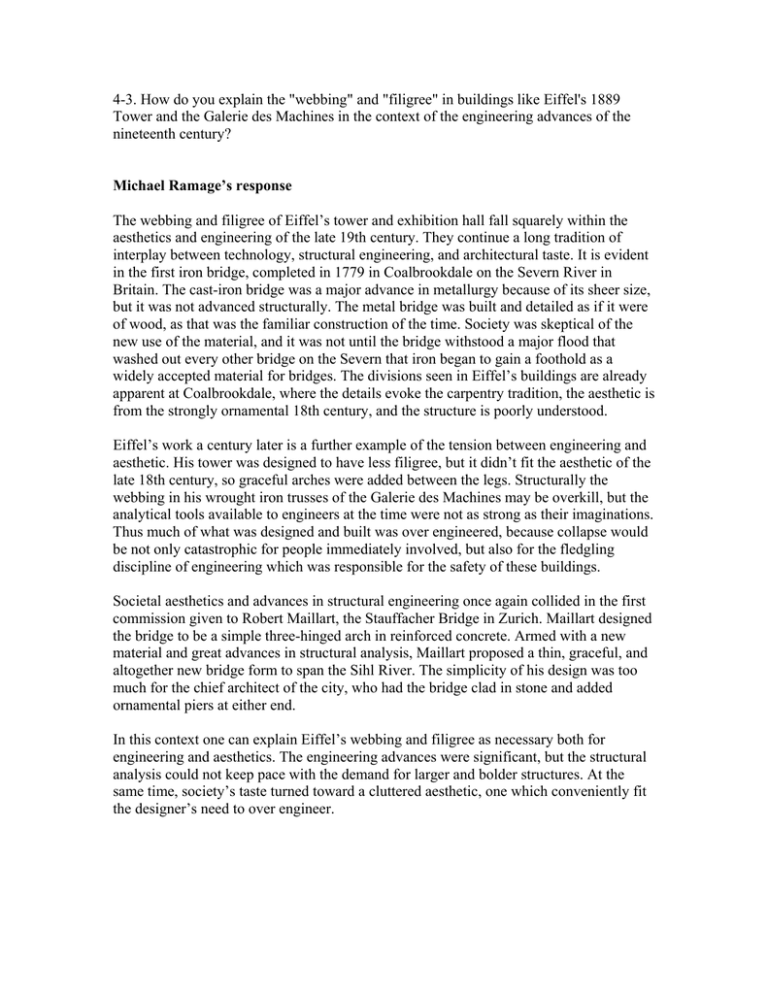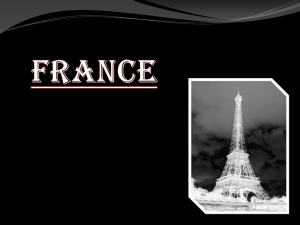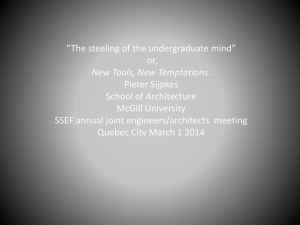4-3. How do you explain the "webbing" and "filigree" in... Tower and the Galerie des Machines in the context of...
advertisement

4-3. How do you explain the "webbing" and "filigree" in buildings like Eiffel's 1889 Tower and the Galerie des Machines in the context of the engineering advances of the nineteenth century? Michael Ramage’s response The webbing and filigree of Eiffel’s tower and exhibition hall fall squarely within the aesthetics and engineering of the late 19th century. They continue a long tradition of interplay between technology, structural engineering, and architectural taste. It is evident in the first iron bridge, completed in 1779 in Coalbrookdale on the Severn River in Britain. The cast-iron bridge was a major advance in metallurgy because of its sheer size, but it was not advanced structurally. The metal bridge was built and detailed as if it were of wood, as that was the familiar construction of the time. Society was skeptical of the new use of the material, and it was not until the bridge withstood a major flood that washed out every other bridge on the Severn that iron began to gain a foothold as a widely accepted material for bridges. The divisions seen in Eiffel’s buildings are already apparent at Coalbrookdale, where the details evoke the carpentry tradition, the aesthetic is from the strongly ornamental 18th century, and the structure is poorly understood. Eiffel’s work a century later is a further example of the tension between engineering and aesthetic. His tower was designed to have less filigree, but it didn’t fit the aesthetic of the late 18th century, so graceful arches were added between the legs. Structurally the webbing in his wrought iron trusses of the Galerie des Machines may be overkill, but the analytical tools available to engineers at the time were not as strong as their imaginations. Thus much of what was designed and built was over engineered, because collapse would be not only catastrophic for people immediately involved, but also for the fledgling discipline of engineering which was responsible for the safety of these buildings. Societal aesthetics and advances in structural engineering once again collided in the first commission given to Robert Maillart, the Stauffacher Bridge in Zurich. Maillart designed the bridge to be a simple three-hinged arch in reinforced concrete. Armed with a new material and great advances in structural analysis, Maillart proposed a thin, graceful, and altogether new bridge form to span the Sihl River. The simplicity of his design was too much for the chief architect of the city, who had the bridge clad in stone and added ornamental piers at either end. In this context one can explain Eiffel’s webbing and filigree as necessary both for engineering and aesthetics. The engineering advances were significant, but the structural analysis could not keep pace with the demand for larger and bolder structures. At the same time, society’s taste turned toward a cluttered aesthetic, one which conveniently fit the designer’s need to over engineer. Iron Crochet Nathalie Westervelt It seems unlikely that the interlaced iron work of the Galerie des Machines and the Eiffel Tower could be examined in terms of aesthetic taste, especially because of the initial adverse response to the Eiffel Tower in particular. What seems more likely is that the filigree and webbing were more dependent upon the new materiality of iron, its structural requirements and society’s need for and development of mass production. If aesthetics were at all an issue, it could be argued that by the use of elements of iron that were non-structural in these constructions, aesthetics were a concern. The forms that were used in the arcades and the Gothic-inspired Eiffel Tower are recognizable. In the Arcades Project, Benjamin states that technology is often aesthetically developed along recognizable lines: “In the beginning, railroad cars look like stagecoaches, autobuses like omnibuses, electric lights like gas chandeliers, and the last like petroleum lamps.” (p.167 Benjamin) Thus the arches that were recreated in iron were of Gothic and Roman influence. These new arches, however, were not stone and therefore reached soaring heights with less material than before. The open-air structure of the Eiffel Tower inspired “The sensation of being enveloped by a floating airspace while walking through tall structures advanced the concept of flight before it had been realized and simulated the formation of the new architecture.” (p.102 'Ferro Concrete Construction') The visitor to the Eiffel Tower is encased in a cage of trusses and introduced to what was, when it was built, a new experience of the built environment. Truss, according to New Webster’s Dictionary, 1992: ‘truss (trus) n. 2 A braced framework of ties, beams or bars, usually arranged in a series of triangles.” The very configuration of a truss, although structural in intention would yield visually what could be signified as webbing. Each element of this webbing had a fine grain due to the fact that it was a repeated element of the same proportions as each other. Iron was useful as a material of massproduced elements. “As the population shifted from rural to urban in the industrializing countries… nations had to build more working and living space. The only way to do this was to mass-produce buildings and infrastructure, and this meant that building methods had to change.” (p.35 Peters) “Repetitive structure, modular elements, system thinking, monolithic structure, and modern statics and material science all made their debut in this period.” (p.35 Peters) Advancements in iron work were continuous and “it did not take them long to discover how inappropriate wedged, pegged and mortised cast-iron connections were…it was better to cast lugs and flanges on the components, as boilermakers did, and join them with wrought-iron bolts and rivets.” (p.38 Peters) Formwork for iron could be reused, therefore it is logical to create patterns of repeatable elements that then could be bolted together. The result is a certain kind of webbing, mechanical by nature was later transfigured into the human-made organic Art Nouveau (which was, as far as I know, a Belgian movement, Jugendstil or no Jugendstil). The machined nature of iron elements is evident in three bridges bult in the 1800's (Wilson’s Wear Bridge, Renne’s Thames Bridge and Telford’s Mythe Bridge). These were designed with “a bottom-up design process, standardizing the members and connections as they went and arranging them into an assembly. Their “kit of parts” determined the final form as much as the form influenced the parts – a form of matrix thinking.” (p. 40 Peters)) Again, the multiple repeated parts, like bones of a skeleton or stitches of crochet, create these web-like structures. The argument for the need for mass production and the demands of loads on the structure which were answered by trusses and diagonal bracing, seem more important to the filigreed result than any simple aesthetic reaction. In this instance, aesthetics seem to have been less important to the webbing that resulted than driving force of technology's promise to create more, faster. James Smith's response The construction of the Eiffel Tower and the Galerie des Machines symbolize the advancement of Iron and steel construction since Joseph Paxton’s 1851 design for the Crystal Palace. Paxton utilized two major innovations of the Industrial Revolution, mass production of pre-fabricated building components and the use of iron and glass in structures. Elements such as “webbings” and “filigrees” in Eiffel’s Tower and the Galerie des Machines can be explained through the development of Iron in structures and the construction process that resulted in the advancement of iron as a primary building material. Advancements in the use of iron as a primary construction material can be seen in the intricate design and use of iron found in the Eiffiel Tower. Gustave Eiffel’s design for a 300 meter tower in Paris for the 1889 Worlds Fair incorporated the ideas of design and construction formulated by Paxton. The detailed design forced an evolution of the construction process that Paxton had developed for the Crystal Palace. According to Tom Peters, “The primacy of connection technology in iron changed the way designers thought about construction.”(Peters 42) Designers were forced to produce detailed designs that enabled workers to pre-fabricate iron components off site. “Iron construction is therefore the process of assembling pre-fabricated components and pre-fabricated connectors.” (42) The formation of mass-production techniques, using and reusing cast molds resulted in the design of structures which utilized repeating elements. “Repetitive elements and standardized connections characterize a system approach to design that implies organizing component hierarchies rather than composing forms. In this way the material, iron, brought forth a new concept, the construction system.”(42) Wrought-Iron components were easy to standardize, primarily because wrought-Iron is as good in tension as in compression. This allows for a uniform dimension that is easier to work with. As iron construction developed in the 19th century following Paxton’s Crystal Palace a new field of science was emerging that dramatically affected our understanding of materials and their properties, Material Sciences. According to Peters this “promoted experimentation with cast-iron components in which engineers would locally increase the cross section of highly stresses areas, giving them highly attractive, sculptural qualities.”(44) The Eiffel Tower and the Galerie des Machines symbolize the advancement of industrial technology since London’s Crystal Palace Exhibition in 1851 by Joseph Paxton. Constructed of 7000 tons of wrought-iron, Eiffel’s Tower became a symbol of the Industrial Revolution. Located at the base of Eiffel’s Tower the Galerie des Machines was a quarter mile long, 460 feet wide and had the largest open floor area of any building ever made. Ornament, Iron, and the 19th Century Bourgeoisie Robert Campos “For a long time, the magnificent views of the city provided by the new iron constructions were accessible only to the workers and engineers. For who at that time, other than the engineer and the proletarian, climbed the steps that gave sole access to what was decisively new about these buildings—their spatial feeling?” From Walter Benjamin, Gesammelte Schriften,, quoted in Wohlfarth, 183 [emphasis added] The webbing and filigree which embellish the Galerie des Machines and the Tour d’Eiffel are not structural, but rather quasi-structural ornament. The bareness of the new iron structures was disturbing to the new bourgeois class who, unable to reconcile new means of production with the new relations of production these changes engendered (and the inevitability, at least to Marx and his followers, of proletarian revolution), retreated into the interiority of their overstuffed homes (Wohlfarth). The unmitigated exteriority of the new iron construction, with its skeletal structure, its “disenchentanted” display of naked metal, was both the “immense turbulence…of industry” that had to be kept “at bay”, (Wohlfarth quoting Dolf Sternberger, 153) and the very (well-upholstered) “iron cage” which keeps those forces at bay, i.e. out of the home. Filigree and webbing are the upholstery, rendered in iron, that interiorizes the Tower and the Galerie for consumption by the bourgoisie. If the above quote describes a latent (structural?) alliance between the proletarian and the engineers within the territory afforded by new technologies, and thereby the means and relations of its production (the Marxian dialectic), then Jugendstil is the bourgeoisie’s reclaiming of that territory. Ornamented iron is the architectonic manifestation of that reclaiming, a “false consciousness” constructed for the proletariat. Benjamin again: [Jugendstil’s] recourse to technical motifs derives from the attempt to sterilize them by way of ornament.” (Quoted in Wohlfarth, 157). Ornament is the “phantasmagoria” which masks the “scaffolding” or “armature” of the bourgeois class “at the moment that it shows its first signs of decline.” (Benjamin, passim). Surrealism, psychoanalysis, historical materialism, all sought to peel away the “filigree and webbing” from the iron structure, or “iron cage” of (modern) reality.





